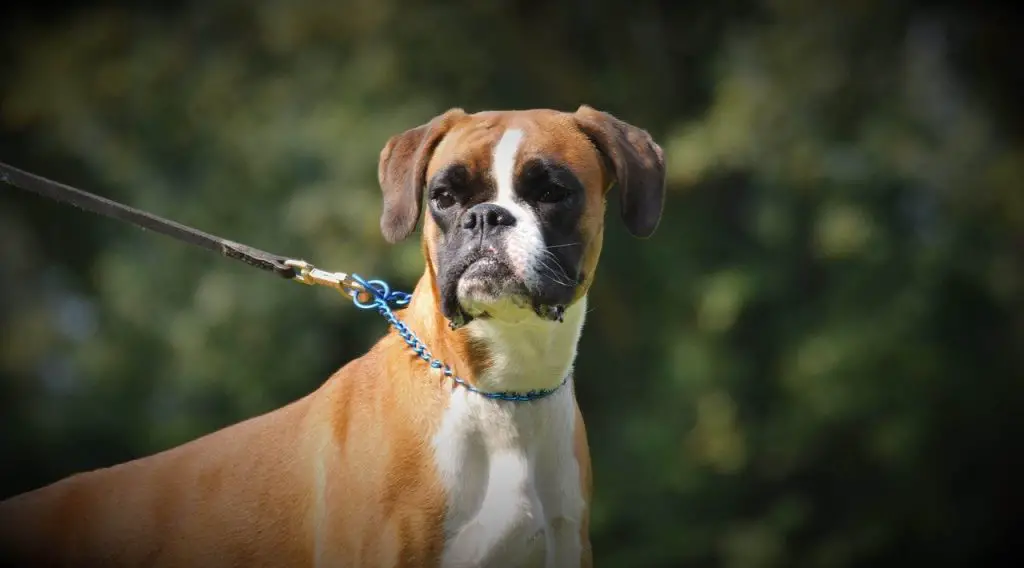Overview
Group: Working Group
AKC Breed Popularity Rank: No. 11 of 195
Height: Male – 23-25 inches; Female – 21.5-23.5 inches
Weight: Male – 65-80 lbs; Female – Around 15 lbs less than male
Life Span: 10-12 years
Temperament: Active; Smart; Fun-loving
Despite its seemingly imposing mug, the Boxer is a wonderful dog with a huge personality. In fact, Boxer lovers claim that every positive quality you desire in a dog can be found in this breed alone, so much so that you no longer need to look at other breeds. It certainly is no wonder, therefore, that the Boxer continues to be one of the most popular dogs in the world.
History
The Boxer’s earliest ancestors can be traced way back to 2,500 B.C. Back then, these ancestors served as war dogs in Assyrian armies. Move ahead to the late 1800s and the 19th century. The Germans, then quite fond of hunting and brutal dog sports, developed a large, heavy breed called the Bullenbeiser (“bull biter”). With its massive size, the Bullenbeiser can track down huge game, such as bison, wild boars, and even bears, and fight in bull-baiting sports.
Eventually, the political situation in Germany changed, leading to the loss of favor of the German nobles. However, breeders saw potential in the Bullenbeiser and sought to transform the savage beast into something a bit smaller and nobler. Carefully crossing it with the smaller, English mastiff breeds, the result is the Boxer that we know of today. Its name came from its way of raising its front paws when defending or playing, much like a sparring boxer.
Presently, Boxers have taken on a huge variety of roles, including police dog, war dog, protection dog, and guide dog for the blind. In history, a notable pair of Boxers were Punch and Judy. In 1946, the two dogs saved their master, a British officer and his friend, during a terrorist attack. Judy suffered also suffered a graze while covering Punch, who was shot four times, with her body. For their bravery in service, Punch and Judy were awarded the Dickin Medal, which is the animal equivalent of England’s distinguished Victoria Cross.
General Appearance
Boxers are sleek, compact, and muscular dogs. Medium-sized, they are squarely built with a short, strong back, and equally strong limbs. Their coat is short and tight-fitting, coming in fawn and brindle colors. It has a distinctive head, with a blunt muzzle that is proportionate to the size of the skull. The Boxer has an expressive face, characterized by dark brown eyes and a wrinkled forehead, giving it an alert but curious look.
While Boxers may seem proud and aloof at first glance, they are, in truth, lovable, and very intelligent dogs, with a strong affection for their owners. They are especially patient and protective of their owners’ children and will watch over them bravely.
Nutrition
Boxers need high quality dog food with a rich protein content. It is important to give them dog food that is appropriate to their age. Aside from protein, Boxers also need calcium, L-carnitine, and taurine to maintain their joints’ health. Because treats can aid in their training, always remember to give them in moderation so that you don’t have an overweight or obese dog on your hands. An energetic dog, Boxers need to have clean, fresh water at all times.
Please note that Boxers are prone to food allergies. If your dog develops symptoms that point to an allergy, gradually eliminate certain foods from their diet under your veterinarian’s supervision.
Grooming
Because of its short, tight coat, the Boxer does not require much grooming. It is sufficient to brush them once a week with a hound glove or a rubber curry brush. You also only give them the occasional bath when they become dirty. To prevent pain while running, make sure to trim their nails regularly. Their teeth should also be brushed often to prevent tartar build up.
Exercise
Athletic and energetic dogs, Boxers need exercise twice a day. You can take them out for a walk or run on a leash or within a secured or fenced area. Because of their ingrained talent for leaping and jumping in pursuit of wild game, they need to be taught early on to heed the commands “sit” and “down”. Their bouncy nature makes them unsuitable for very small children and frail adults/seniors.
Training
Training and socialization of the Boxer should begin when they are still puppies. Because of their intelligence, they easily get bored with repetitive training. They can also be quite willfull and are great problem solvers. In training Boxers, opt for a variety of activities to keep them interested. Maintain positivity instead of giving them harsh punishment. Aside from obedience and agility, you might want to consider having your Boxer trained for certain jobs, such as therapy, service, assistance, and/or search-and-rescue.
Health
Boxers do not tolerate temperature extremes very well. After brisk exercise, Boxers are best kept indoors with the family. Although responsible breeders make sure that their puppies are healthy, it is advisable to have your dog checked out for certain medical conditions, such as hip dysplasia, cardiomyopathy, degenerative myelopathy, and cancer.
Costs
On average, Boxer puppies cost $800 but may go as high as $1,700 to $10,000 for top quality lines. It is estimated that annual upkeep costs are between $500 and $2,000 for the first year and then $500-$1,000 in succeeding years.
Despite their huge price tags, Boxer lovers can attest to the worthiness of the breed in terms of loyalty, affection, and protectiveness.
SOURCES:
1) Boxer https://www.akc.org/dog-breeds/boxer/
2) Punch and Judy http://www.vconline.org.uk/punch-and-judy-dm/4594665693
3) Dog Lovers Know The Best Dog Foods for Boxer Breed Dogs and Puppies https://www.jpost.com/PromoContent/Pets/Dog-Lovers-Know-The-Best-Dog-Foods-for-Boxer-Breed-DogsPuppies-445276
4) Boxer Puppies for Sale https://www.nextdaypets.com/Boxer.htm


